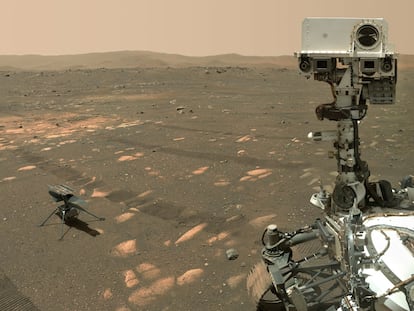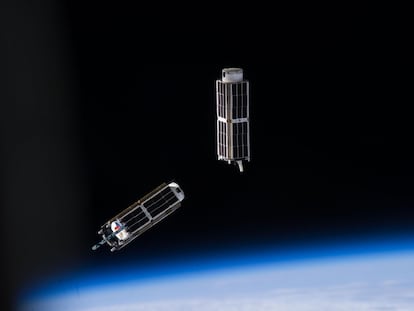End of mission: NASA loses communication with the InSight lander
The probe was the first ever to record marsquakes and reveal the planet’s active volcanic regions
InSight, the first space lander ever to collect data on seismic activity on another planet and reveal its interior structure, is now officially considered retired after two failed communication attempts. The last time that NASA managed to establish a connection with this van-sized spacecraft located near the equator of Mars was on December 15. Those responsible for the mission were aware that they were going to lose contact with it, because its solar panels were for months getting covered with a fine layer of Martian dust that depleted its batteries.
Throughout this year, mission engineers made desperate attempts to save the spacecraft. They shook the panels and even used the robotic arm to throw sand on them, hoping that would clean them, but to no avail. Now, the lander is part of the Martian landscape and no more marsquakes will be captured, laments Simon Stähler, a geophysicist at the Swiss Federal Polytechnic School and member of the mission’s scientific team.
The last hope is that a small tornado blows away the dust, as happened with the Spirit and Opportunity probes, but the chances are slim. The InSight cannot move and this would only work if it happens soon, as the spacecraft’s electronic equipment and batteries will soon freeze beyond repair, explains Stähler.
InSight carried the first seismometer ever installed on another planet, and with it made a historic discovery: that Mars is not a geologically dead planet. Its insides move, as confirmed by the 1,319 tidal waves that it captured since it landed on the red planet in May 2018.
In October of that year, when the spacecraft’s fate was already sealed due to the lack of energy, the mission’s scientific team revealed that the InSight had captured the marsquakes caused by two meteorite impacts in 2021. The seismic alert activated by InSight allowed an orbiting spacecraft to locate the crater of one of the impacts, which was 150 meters in diameter and revealed at least a ton of ice.
This is the first time that humanity has captured seismic activity on another planet and created a seismic warning system
The name “InSight” is a compression of the mission’s full name: Interior Exploration Using Seismic Investigations, Geodesy and Heat Transport – from the interior of the planet to its surface. The project cost $828.8 million and it revealed the internal structure of the red planet. Accumulated data shows that the outermost layer, the crust, is about 30 kilometers thick. Seismic signals from approximately 500 marsquakes also made it possible to confirm that Mars harbors a liquid core with a diameter of around 1,800 kilometers, half of that of Earth.
This is the first time that humanity has captured seismic activity on another planet and created a seismic warning system. The only precedent – quite a rudimentary one – was carried out by the astronauts of the Apollo program in the 1970s, when they detonated explosives on the Moon to cause seismic waves and study the interior of the satellite, in this case totally dead.
The InSight mission had an important contribution from France, Switzerland, the United Kingdom, Poland and Spain, which developed the temperature and wind sensors. Philippe Lognonné, from the Paris Institute of Earth Physics, is the principal investigator of the seismometer. “We broke new ground, and our science team can be proud of all that we’ve learned along the way,” he emphasized in a NASA press release.
InSight’s biggest scientific surprise came this month, just 10 days before contact with the spacecraft was lost. According to a team of researchers from the University of Arizona that analyzed data from several orbital probes as well as the seismic movements, Mars is home to an active volcanic region that is about the size of Western Europe and could erupt at any time. It’s quite a paradigm shift for a planet that, until this ship arrived, was thought to be completely dead on the inside.
Sign up for our weekly newsletter to get more English-language news coverage from EL PAÍS USA Edition
Tu suscripción se está usando en otro dispositivo
¿Quieres añadir otro usuario a tu suscripción?
Si continúas leyendo en este dispositivo, no se podrá leer en el otro.
FlechaTu suscripción se está usando en otro dispositivo y solo puedes acceder a EL PAÍS desde un dispositivo a la vez.
Si quieres compartir tu cuenta, cambia tu suscripción a la modalidad Premium, así podrás añadir otro usuario. Cada uno accederá con su propia cuenta de email, lo que os permitirá personalizar vuestra experiencia en EL PAÍS.
¿Tienes una suscripción de empresa? Accede aquí para contratar más cuentas.
En el caso de no saber quién está usando tu cuenta, te recomendamos cambiar tu contraseña aquí.
Si decides continuar compartiendo tu cuenta, este mensaje se mostrará en tu dispositivo y en el de la otra persona que está usando tu cuenta de forma indefinida, afectando a tu experiencia de lectura. Puedes consultar aquí los términos y condiciones de la suscripción digital.
More information
Últimas noticias
Welcome to the post-religion era: The idea of Christianity as the absolute truth has become obsolete
‘I thought you would like it’: The risky sexual practice popularized by TV shows and TikTok
The digitalization of tourism: ‘They promise experiences and gave us the worst possible one’
Mexican peso defies uncertainty with forecasts of a new period of stability in 2026
Most viewed
- Sinaloa Cartel war is taking its toll on Los Chapitos
- Reinhard Genzel, Nobel laureate in physics: ‘One-minute videos will never give you the truth’
- Oona Chaplin: ‘I told James Cameron that I was living in a treehouse and starting a permaculture project with a friend’
- Why the price of coffee has skyrocketed: from Brazilian plantations to specialty coffee houses
- Silver prices are going crazy: This is what’s fueling the rally











































